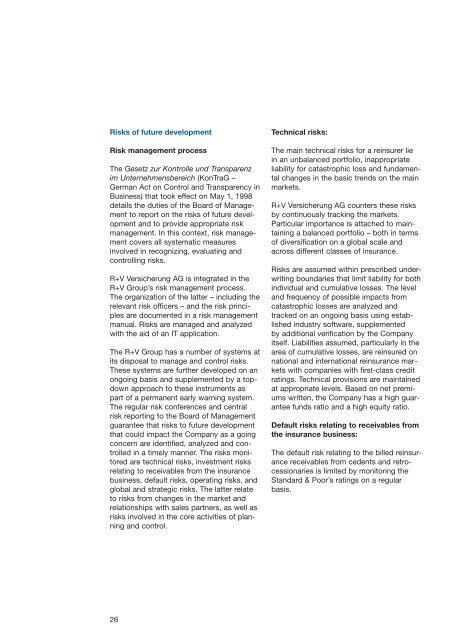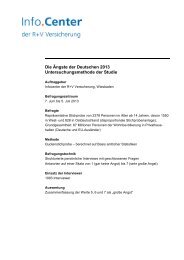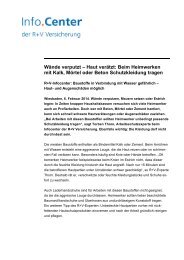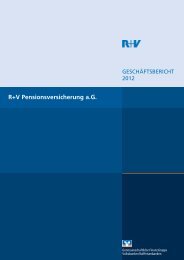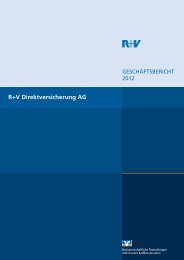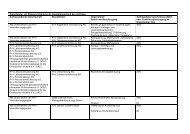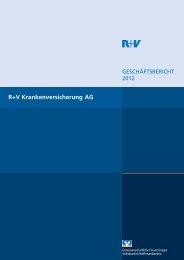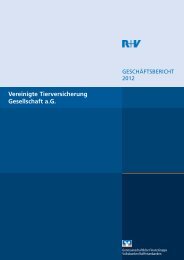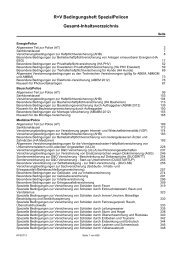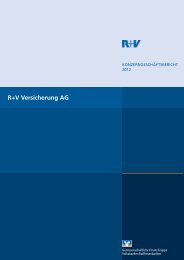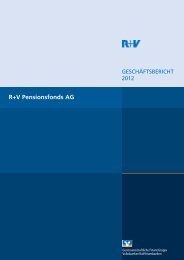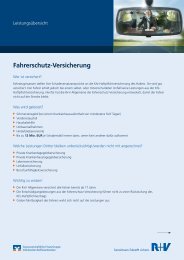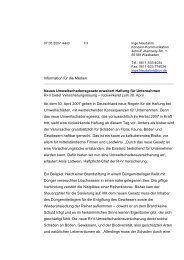R+V Versicherung AG Annual Report
R+V Versicherung AG Annual Report
R+V Versicherung AG Annual Report
You also want an ePaper? Increase the reach of your titles
YUMPU automatically turns print PDFs into web optimized ePapers that Google loves.
Risks of future development<br />
Risk management process<br />
The Gesetz zur Kontrolle und Transparenz<br />
im Unternehmensbereich (KonTraG –<br />
German Act on Control and Transparency in<br />
Business) that took effect on May 1, 1998<br />
details the duties of the Board of Management<br />
to report on the risks of future development<br />
and to provide appropriate risk<br />
management. In this context, risk management<br />
covers all systematic measures<br />
involved in recognizing, evaluating and<br />
controlling risks.<br />
<strong>R+V</strong> <strong>Versicherung</strong> <strong>AG</strong> is integrated in the<br />
<strong>R+V</strong> Group’s risk management process.<br />
The organization of the latter – including the<br />
relevant risk officers – and the risk principles<br />
are documented in a risk management<br />
manual. Risks are managed and analyzed<br />
with the aid of an IT application.<br />
The <strong>R+V</strong> Group has a number of systems at<br />
its disposal to manage and control risks.<br />
These systems are further developed on an<br />
ongoing basis and supplemented by a topdown<br />
approach to these instruments as<br />
part of a permanent early warning system.<br />
The regular risk conferences and central<br />
risk reporting to the Board of Management<br />
guarantee that risks to future development<br />
that could impact the Company as a going<br />
concern are identified, analyzed and controlled<br />
in a timely manner. The risks monitored<br />
are technical risks, investment risks<br />
relating to receivables from the insurance<br />
business, default risks, operating risks, and<br />
global and strategic risks. The latter relate<br />
to risks from changes in the market and<br />
relationships with sales partners, as well as<br />
risks involved in the core activities of planning<br />
and control.<br />
26<br />
Technical risks:<br />
The main technical risks for a reinsurer lie<br />
in an unbalanced portfolio, inappropriate<br />
liability for catastrophic loss and fundamental<br />
changes in the basic trends on the main<br />
markets.<br />
<strong>R+V</strong> <strong>Versicherung</strong> <strong>AG</strong> counters these risks<br />
by continuously tracking the markets.<br />
Particular importance is attached to maintaining<br />
a balanced portfolio – both in terms<br />
of diversification on a global scale and<br />
across different classes of insurance.<br />
Risks are assumed within prescribed underwriting<br />
boundaries that limit liability for both<br />
individual and cumulative losses. The level<br />
and frequency of possible impacts from<br />
catastrophic losses are analyzed and<br />
tracked on an ongoing basis using established<br />
industry software, supplemented<br />
by additional verification by the Company<br />
itself. Liabilities assumed, particularly in the<br />
area of cumulative losses, are reinsured on<br />
national and international reinsurance markets<br />
with companies with first-class credit<br />
ratings. Technical provisions are maintained<br />
at appropriate levels. Based on net premiums<br />
written, the Company has a high guarantee<br />
funds ratio and a high equity ratio.<br />
Default risks relating to receivables from<br />
the insurance business:<br />
The default risk relating to the billed reinsurance<br />
receivables from cedents and retrocessionaries<br />
is limited by monitoring the<br />
Standard & Poor’s ratings on a regular<br />
basis.


